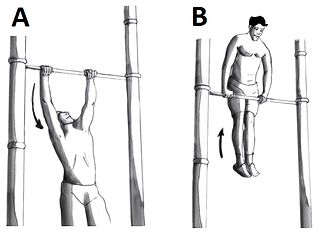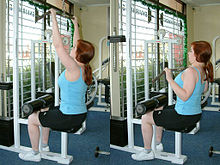Muscles
The standard pull-down motion is a compound movement that requires dynamic work by muscles surrounding the three joints which move during the exercise. These are the elbow in conjunction with the glenohumeral and scapulothoracic joints in the shoulder girdle.
Latissimus dorsi
The latissimus dorsi performs extension and adduction of the arm directly to the spinal fascia. It bypasses the scapulae unlike other muscles which perform this function, so work performed by this muscle will not contribute to muscles that affect the scapulae. The lower sternal fibers of the pectoralis major also perform this role of extension and adduction to a lesser degree.
The contraction of these adductor/extensor muscles can indirectly depress and downwardly rotate the scapulae; this is only required when they are pulled into elevation and upward rotation by the contraction of muscles that attach to the scapulae. If the weight were being pulled solely by the lats, for example, the scapulae would simply be pulled down by gravity, along for the ride.
Elbow
Muscles which flex the elbow joint such as the biceps brachii muscle, brachialis muscles and brachioradialis muscle are active to improve leverage. [1] As the biceps originate on the scapula unlike the other two which originate on the humerus, the biceps are inclined to serve a role as a dynamic stabilizer, much as the hamstrings would during a squat. This is because, while the biceps shortens as the elbow flexes, it will also lengthen as the shoulder extends. [2]
A supinated grip at the forearm allows the biceps to contribute more strongly as an elbow flexor. A prone grip will rely more greatly on the other flexors, the brachialis and brachioradialis.
Using a pronated grip during pull-downs tends to result in the greatest activation of the latissimus dorsi, with no difference in latissimus dorsi activity between grip widths. [3]
The pull-down usually uses a weight machine with a seat and brace for the thighs. The starting position involves sitting at the machine with the thighs braced, back straight and feet flat on the floor. The arms are held overhead at full extension, grasping a bar connected to the weight stack. The movement is initiated by pulling the elbows down and back, lowering the bar to the neck, and completed by returning to the initial position.
Variations
Narrow grip underhand pull-down begin
Narrow grip underhand pull-down end
Narrow grip neutral pull-down begin
Narrow grip neutral pull-down end
Narrow grip overhand pull-down begin
Narrow grip overhand pull-down end
Wide grip overhand pull-down begin
Wide grip overhand pull-down end
Variations can include touching the bar to the chest (sternum) versus the back of the neck, [1] or varying hand spacing (wide versus narrow) or orientation (pronated versus supinated). The exercise can also be done using cable machines, a handle attached to a cable is pulled toward the body, this can be done while seated on a bench or stability ball, kneeling, or in a standing or squatting position. The number of repetitions and weight moved varies according to the specific training plan of the person training. [4]
The chin-up/pull-up is a very similar exercise that moves the body against a fixed bar rather than moving a bar against a fixed body. [1]
Behind neck
This variation of the lat pull-down, in which the bar is pulled behind the neck, may be dangerous and less effective. [5] Behind the neck lat pull-downs offer no biomechanical advantages. [6] It can cause compression of the cervical spine disks, and disk damage if contact is made by striking the bar to the neck. In addition, it can cause rotator cuff injuries. [7]
Muscle involvement
If the weight is pulled to touch the front of the chest, the rhomboid muscles' work may increase, while pulling the weight down to touch the back of the neck may work the upper trapezius muscle. [1]
Etymology
The "lat" sometimes added before "pull-down" commonly refers to the latissimus dorsi used in the movement.
Most exercises describe the muscle that is involved and the direction of the exercise e.g. biceps curl, triceps extension, leg press, hamstring curl, abdominal curl and so on.
Although "lat" can be first thought as short for "lateral", the term lateral means sideways and away from the body, which only describes the direction of the humerus during the eccentric portion of the movement (during which the bar is being raised, not pulled down). This means "lateral" is not an ideal term to describe the movement, it is an adjective more appropriate in usage such as lateral raise.

The humerus is a long bone in the arm that runs from the shoulder to the elbow. It connects the scapula and the two bones of the lower arm, the radius and ulna, and consists of three sections. The humeral upper extremity consists of a rounded head, a narrow neck, and two short processes. The body is cylindrical in its upper portion, and more prismatic below. The lower extremity consists of 2 epicondyles, 2 processes, and 3 fossae. As well as its true anatomical neck, the constriction below the greater and lesser tubercles of the humerus is referred to as its surgical neck due to its tendency to fracture, thus often becoming the focus of surgeons.

The biceps or biceps brachii is a large muscle that lies on the front of the upper arm between the shoulder and the elbow. Both heads of the muscle arise on the scapula and join to form a single muscle belly which is attached to the upper forearm. While the biceps crosses both the shoulder and elbow joints, its main function is at the elbow where it flexes the forearm and supinates the forearm. Both these movements are used when opening a bottle with a corkscrew: first biceps screws in the cork (supination), then it pulls the cork out (flexion).

The latissimus dorsi is a large, flat muscle on the back that stretches to the sides, behind the arm, and is partly covered by the trapezius on the back near the midline. The word latissimus dorsi comes from Latin and means "broadest [muscle] of the back", from "latissimus" ' and "dorsum". The pair of muscles are commonly known as "lats", especially among bodybuilders. The latissimus dorsi is the largest muscle in the upper body.

The deltoid muscle is the muscle forming the rounded contour of the human shoulder. It is also known as the 'common shoulder muscle', particularly in other animals such as the domestic cat. Anatomically, the deltoid muscle appears to be made up of three distinct sets of muscle fibers, namely the
- anterior or clavicular part
- posterior or scapular part
- intermediate or acromial part

The upper limbs or upper extremities are the forelimbs of an upright-postured tetrapod vertebrate, extending from the scapulae and clavicles down to and including the digits, including all the musculatures and ligaments involved with the shoulder, elbow, wrist and knuckle joints. In humans, each upper limb is divided into the arm, forearm and hand, and is primarily used for climbing, lifting and manipulating objects.
Bicep curls are a group of weight training exercises in which a person bends their arm towards their body at the elbow in order to make their biceps stronger.

The triceps, or triceps brachii, is a large muscle on the back of the upper limb of many vertebrates. It consists of 3 parts: the medial, lateral, and long head. It is the muscle principally responsible for extension of the elbow joint.

The lying triceps extension, also known as skull crusher and French extension or French press, is a strength exercise used in many different forms of strength training. It is one of the most stimulating exercises to the entire triceps muscle group in the upper arm, and works the triceps from the elbow all the way to the latissimus dorsi. Due to its full use of the triceps muscle group, the lying triceps extensions are used by many as part of their training regimen.

The shoulder joint is structurally classified as a synovial ball-and-socket joint and functionally as a diarthrosis and multiaxial joint. It involves an articulation between the glenoid fossa of the scapula and the head of the humerus. Due to the very loose joint capsule that gives a limited interface of the humerus and scapula, it is the most mobile joint of the human body.
A bent-over row is a weight training exercise that targets a variety of back muscles. Which ones are targeted varies on form. The bent over row is often used for both bodybuilding and powerlifting.

A pull-up is an upper-body strength exercise. The pull-up is a closed-chain movement where the body is suspended by the hands, gripping a bar or other implement at a distance typically wider than shoulder-width, and pulled up. As this happens, the elbows flex and the shoulders adduct and extend to bring the elbows to the torso.
The upright row is a weight training exercise performed by holding a weight with an overhand grip and lifting it straight up to the collarbone. This is a compound exercise that involves the trapezius, the deltoids and the biceps. The narrower the grip the more the trapezius muscles are exercised, as opposed to the deltoids.

The muscle-up is an advanced strength training exercise, within the domain of calisthenics. It is a combination routine of a radial pull-up followed by a dip. Variations exist for the rings as well as the bar.

A fly or flye is a strength training exercise in which the hand and arm move through an arc while the elbow is kept at a constant angle. Flies are used to work the muscles of the upper body. Because these exercises use the arms as levers at their longest possible length, the amount of weight that can be moved is significantly less than equivalent press exercises for the same muscles . Due to this leverage, fly exercises of all types have a large potential to damage the shoulder joint and its associated ligaments and the tendons of the muscles connecting to it. They should be done with caution and their effects first tested while using very light weights; which are gradually incremented after more strength is gained.
The term forehand refers to the front half of a horse's body.

The inverted row is an exercise in calisthenics. It primarily works the muscles of the upper back—the trapezius and latissimus dorsi—as well as the biceps as a secondary muscle group. The supine row is normally carried out in three to five sets, but repetitions depend on the type of training a lifter is using to make their required gains. This exercise is lighter on the joints compared to weighted rows. The exercise can also be performed with mixed, underhand, or overhand grips with either wide or narrow hand placement. The exercise is also known under various names such as supine row, bodyweight row, Australian pull up or "horizontal pull-up".
The rear delt raise, also known as the rear deltoid raise, or rear shoulder raise is an exercise in weight training. This exercise is an isolation exercise that heavily works the posterior deltoid muscle. The movement is primarily limited to the two shoulder joints: the glenohumeral joint and the scapulothoracic joint. Scapular movement will also cause movement in the sternoclavicular joint and acromioclavicular joint. If the elbow bends during the extension exercises, it gravitates into a rowing motion.
The face pull is a weight training exercise that primarily targets the musculature of the upper back and shoulders, namely the posterior deltoids, trapezius, rhomboids, as well as the infraspinatus and teres minor muscles of the rotator cuff. The face pull is considered an important exercise for shoulder health and stability.














